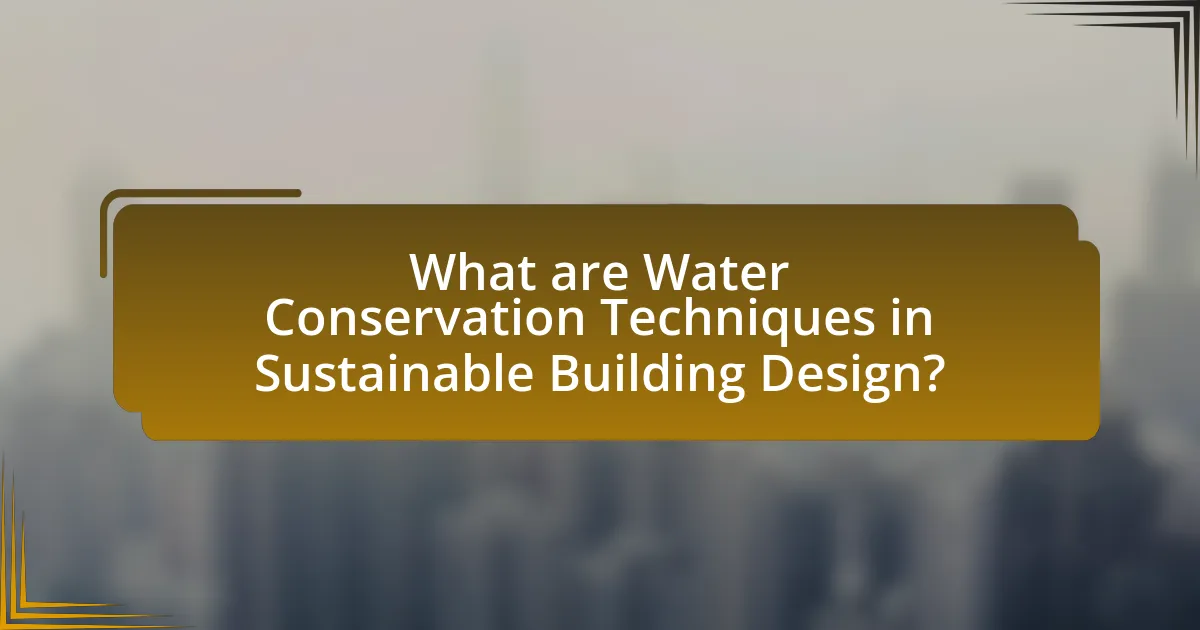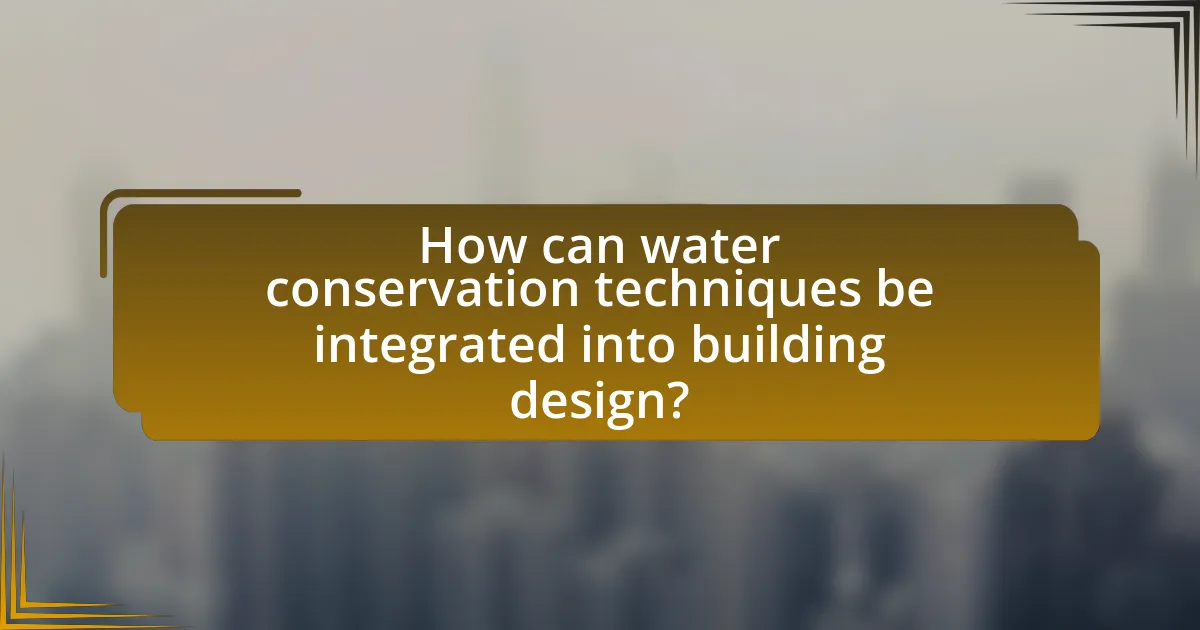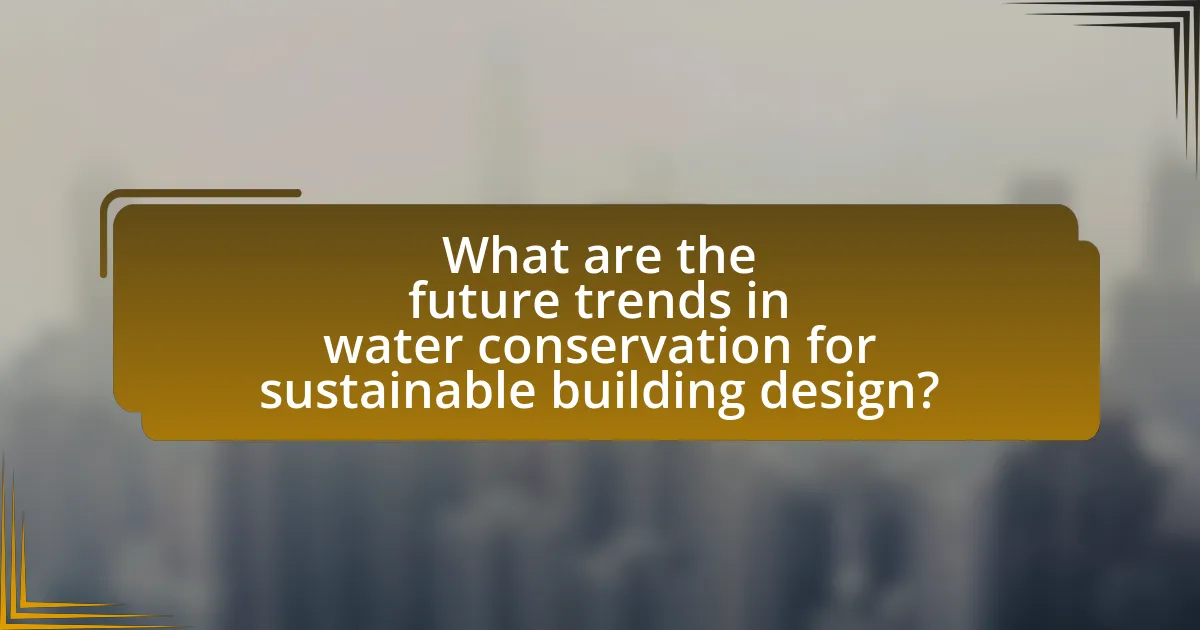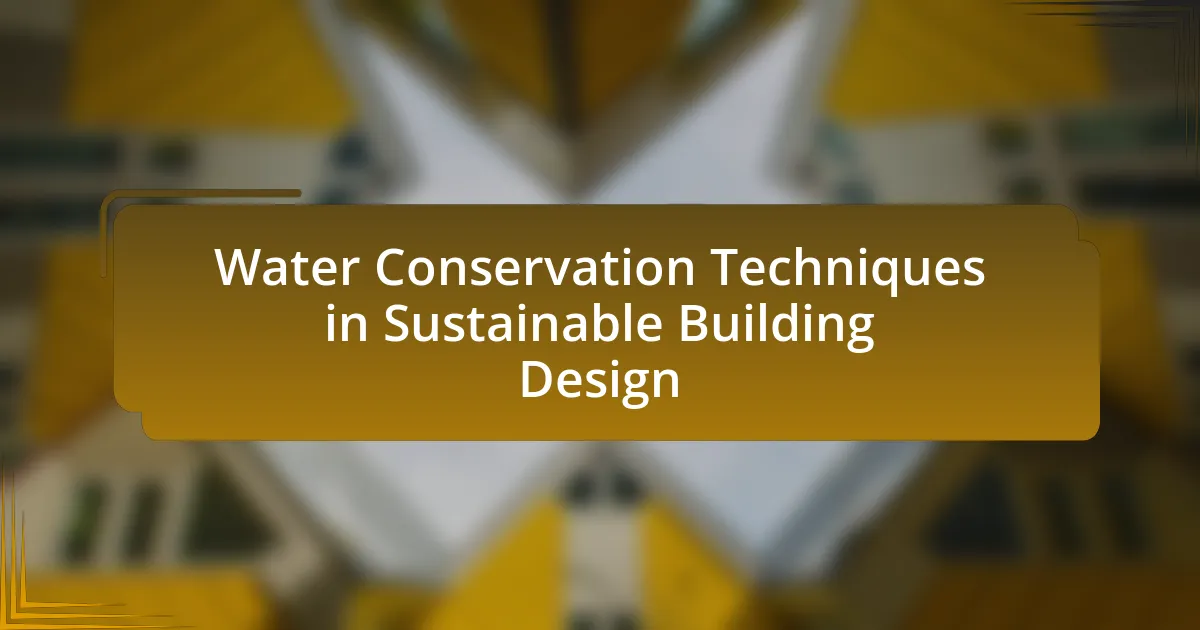Water conservation techniques in sustainable building design are essential for reducing water consumption and minimizing environmental impact. Key methods include rainwater harvesting, greywater recycling, and the installation of low-flow fixtures, all of which contribute to efficient water management and sustainability. These techniques not only decrease reliance on municipal water supplies but also enhance energy efficiency by reducing the energy required for water heating and distribution. The article explores the principles behind these techniques, their economic benefits, and the challenges faced in implementation, while also highlighting future trends and technological innovations that support water conservation in building design.

What are Water Conservation Techniques in Sustainable Building Design?
Water conservation techniques in sustainable building design include rainwater harvesting, greywater recycling, and the use of low-flow fixtures. Rainwater harvesting captures and stores rainwater for non-potable uses, reducing reliance on municipal water supplies. Greywater recycling systems treat and reuse water from sinks, showers, and laundry for irrigation or toilet flushing, significantly decreasing overall water consumption. Low-flow fixtures, such as faucets, showerheads, and toilets, minimize water usage without sacrificing performance, leading to substantial water savings. These techniques collectively contribute to more sustainable water management in buildings, aligning with environmental conservation goals.
How do these techniques contribute to sustainability?
Water conservation techniques in sustainable building design significantly contribute to sustainability by reducing water consumption and minimizing environmental impact. These techniques, such as rainwater harvesting, greywater recycling, and the use of drought-resistant landscaping, help to conserve water resources, decrease reliance on municipal water supplies, and lower energy use associated with water treatment and distribution. For instance, implementing rainwater harvesting systems can reduce potable water use by up to 50%, as reported by the U.S. Environmental Protection Agency. Additionally, greywater recycling can save approximately 30% of water used in residential settings, further enhancing sustainability efforts.
What are the key principles behind water conservation in building design?
The key principles behind water conservation in building design include efficient water use, rainwater harvesting, and the implementation of water-efficient fixtures. Efficient water use focuses on minimizing water consumption through design strategies, such as optimizing landscaping with drought-resistant plants and using greywater systems for irrigation. Rainwater harvesting captures and stores rainwater for non-potable uses, reducing reliance on municipal water supplies. Additionally, installing water-efficient fixtures, such as low-flow faucets and dual-flush toilets, significantly decreases water usage. These principles are supported by studies indicating that buildings designed with these strategies can reduce water consumption by up to 50%, contributing to sustainable building practices.
How do water conservation techniques impact energy efficiency?
Water conservation techniques significantly enhance energy efficiency by reducing the energy required for water heating, distribution, and treatment. For instance, implementing low-flow fixtures and rainwater harvesting systems decreases overall water usage, which in turn lowers the energy needed to pump and heat water. According to the U.S. Environmental Protection Agency, water heating accounts for approximately 18% of a home’s energy use; thus, conserving water directly correlates with reduced energy consumption. Additionally, efficient irrigation practices in landscaping minimize the energy expended on water delivery systems, further contributing to overall energy savings in sustainable building design.
What types of water conservation techniques are commonly used?
Commonly used water conservation techniques include rainwater harvesting, greywater recycling, and the installation of low-flow fixtures. Rainwater harvesting captures and stores rainwater for non-potable uses, significantly reducing reliance on municipal water supplies. Greywater recycling systems treat and reuse water from sinks, showers, and laundry for irrigation and toilet flushing, which can save up to 50% of indoor water use. Low-flow fixtures, such as faucets, showerheads, and toilets, are designed to use less water without sacrificing performance, leading to substantial reductions in water consumption. These techniques are essential in sustainable building design, contributing to environmental conservation and resource efficiency.
What is rainwater harvesting and how is it implemented?
Rainwater harvesting is the process of collecting and storing rainwater for reuse, primarily for irrigation, potable water, and other non-potable uses. Implementation involves several steps: first, a catchment area, typically a roof, is designed to capture rainwater; second, a system of gutters and downspouts directs the water to a storage tank; third, filtration systems are installed to remove debris and contaminants; and finally, the stored water is distributed for use through a plumbing system. According to the United Nations, rainwater harvesting can reduce reliance on traditional water sources and promote sustainable water management practices.
How does greywater recycling work in sustainable buildings?
Greywater recycling in sustainable buildings involves the collection, treatment, and reuse of wastewater from sources like sinks, showers, and washing machines for non-potable applications. This process typically includes a filtration system to remove contaminants, followed by biological treatment or disinfection methods to ensure safety. The treated greywater can then be utilized for irrigation, toilet flushing, or cooling systems, significantly reducing the demand for freshwater. According to the U.S. Environmental Protection Agency, greywater recycling can save up to 50% of water usage in residential settings, demonstrating its effectiveness in promoting water conservation in sustainable building design.
What role do low-flow fixtures play in water conservation?
Low-flow fixtures significantly reduce water consumption, playing a crucial role in water conservation. These fixtures, such as low-flow toilets, showerheads, and faucets, are designed to use less water while maintaining performance. For instance, low-flow toilets can use as little as 1.28 gallons per flush compared to traditional models that use 3.5 to 7 gallons. According to the U.S. Environmental Protection Agency, replacing older fixtures with low-flow alternatives can save an average household over 13,000 gallons of water annually. This reduction not only conserves water resources but also decreases the energy required for water heating and wastewater treatment, further contributing to sustainability efforts in building design.
Why is water conservation important in building design?
Water conservation is crucial in building design because it reduces resource depletion and minimizes environmental impact. Efficient water use in buildings can lead to significant reductions in water consumption, which is essential in areas facing water scarcity. According to the U.S. Environmental Protection Agency, buildings account for nearly 12% of total water use in the United States, highlighting the potential for conservation efforts to make a substantial difference. Implementing water-efficient fixtures, rainwater harvesting systems, and greywater recycling can decrease demand on municipal water supplies and lower utility costs for occupants.
How does water conservation affect the environment?
Water conservation positively affects the environment by reducing the depletion of natural water resources and minimizing the energy required for water treatment and distribution. When individuals and communities practice water conservation, they help maintain the balance of local ecosystems, as many habitats depend on consistent water levels. For instance, according to the U.S. Environmental Protection Agency, reducing water use can lead to lower energy consumption, as less energy is needed to pump, treat, and heat water. This reduction in energy use subsequently decreases greenhouse gas emissions, contributing to a healthier atmosphere. Additionally, conserving water helps prevent pollution by reducing runoff and the potential for contaminants to enter waterways, thereby protecting aquatic life and improving water quality.
What are the economic benefits of implementing water conservation techniques?
Implementing water conservation techniques yields significant economic benefits, including reduced utility costs and increased property value. By minimizing water usage, households and businesses can lower their water bills, leading to substantial savings over time. For instance, a study by the American Water Works Association found that implementing water-efficient fixtures can reduce water consumption by up to 30%, translating to savings of approximately $300 annually for an average household. Additionally, properties that incorporate water conservation measures often see an increase in market value, as buyers are increasingly interested in sustainable features. According to the National Association of Home Builders, homes with water-efficient systems can sell for 5-10% more than comparable homes without such features. These economic advantages underscore the importance of water conservation in sustainable building design.

How can water conservation techniques be integrated into building design?
Water conservation techniques can be integrated into building design through the implementation of efficient plumbing fixtures, rainwater harvesting systems, and xeriscaping. Efficient plumbing fixtures, such as low-flow toilets and faucets, significantly reduce water usage, with low-flow toilets using about 1.28 gallons per flush compared to older models that use up to 3.5 gallons. Rainwater harvesting systems capture and store rainwater for non-potable uses, which can reduce reliance on municipal water supply. Xeriscaping involves landscaping with drought-resistant plants, minimizing the need for irrigation. These techniques collectively contribute to sustainable building practices by reducing overall water consumption and promoting environmental stewardship.
What are the best practices for incorporating these techniques?
The best practices for incorporating water conservation techniques in sustainable building design include implementing rainwater harvesting systems, utilizing low-flow fixtures, and designing landscapes with drought-resistant plants. Rainwater harvesting systems can capture and store rainwater for non-potable uses, significantly reducing reliance on municipal water supplies. Low-flow fixtures, such as faucets and toilets, can reduce water consumption by up to 50%, as supported by studies from the U.S. Environmental Protection Agency. Additionally, selecting drought-resistant plants for landscaping minimizes irrigation needs, promoting water efficiency. These practices collectively enhance water sustainability in building design.
How can architects and builders collaborate to enhance water conservation?
Architects and builders can collaborate to enhance water conservation by integrating sustainable design principles and construction practices. This collaboration involves architects designing buildings with features such as rainwater harvesting systems, permeable pavements, and efficient irrigation systems, while builders implement these designs using materials and techniques that minimize water usage. For instance, the use of low-flow fixtures and drought-resistant landscaping can significantly reduce water consumption. Studies show that buildings designed with water conservation in mind can reduce water use by up to 30%, demonstrating the effectiveness of this collaborative approach.
What design strategies maximize the effectiveness of water conservation techniques?
Design strategies that maximize the effectiveness of water conservation techniques include the implementation of rainwater harvesting systems, the use of drought-resistant landscaping, and the installation of low-flow fixtures. Rainwater harvesting systems capture and store rainwater for irrigation and non-potable uses, significantly reducing reliance on municipal water supplies. Drought-resistant landscaping, or xeriscaping, minimizes water usage by selecting native plants that require less irrigation. Low-flow fixtures, such as faucets, showerheads, and toilets, reduce water consumption without sacrificing performance. According to the U.S. Environmental Protection Agency, low-flow fixtures can save an average household over 20,000 gallons of water annually, demonstrating the tangible benefits of these design strategies in promoting water conservation.
What challenges might arise when implementing water conservation techniques?
Implementing water conservation techniques can face several challenges, including high initial costs, resistance to change, and technical limitations. High initial costs can deter stakeholders from adopting new technologies or systems, as investments in efficient fixtures or rainwater harvesting systems may not yield immediate financial returns. Resistance to change often arises from established habits and practices, making it difficult to encourage individuals and organizations to adopt new water-saving behaviors. Technical limitations may include insufficient infrastructure or lack of expertise in installing and maintaining advanced water conservation systems, which can hinder effective implementation. These challenges highlight the complexities involved in promoting water conservation within sustainable building design.
How can these challenges be overcome in sustainable building projects?
Challenges in sustainable building projects can be overcome by implementing advanced water conservation techniques such as rainwater harvesting, greywater recycling, and the use of drought-resistant landscaping. Rainwater harvesting systems can capture and store rainwater for non-potable uses, reducing reliance on municipal water supplies. Greywater recycling systems treat and reuse water from sinks, showers, and laundry for irrigation or toilet flushing, which can save up to 50% of water usage in buildings. Additionally, incorporating drought-resistant landscaping minimizes water consumption by utilizing native plants that require less irrigation. These methods have been shown to significantly decrease water usage and enhance sustainability in building design.
What are common misconceptions about water conservation in building design?
Common misconceptions about water conservation in building design include the belief that low-flow fixtures alone are sufficient for effective water savings and that water-efficient landscaping is not aesthetically pleasing. Many assume that implementing low-flow toilets and faucets will automatically lead to significant water conservation without considering the overall design and integration of water systems. Additionally, some people think that xeriscaping or drought-resistant plants compromise the beauty of a landscape, when in fact, these techniques can enhance visual appeal while reducing water usage. Research indicates that comprehensive water management strategies, which include both efficient fixtures and thoughtful landscaping, can lead to substantial reductions in water consumption, often exceeding 30% in some cases.

What are the future trends in water conservation for sustainable building design?
Future trends in water conservation for sustainable building design include the integration of advanced water recycling systems, the use of smart irrigation technologies, and the implementation of rainwater harvesting systems. Advanced water recycling systems, such as greywater reuse, allow buildings to treat and repurpose water from sinks and showers for irrigation or toilet flushing, significantly reducing overall water consumption. Smart irrigation technologies utilize sensors and weather data to optimize water usage for landscaping, ensuring that plants receive only the necessary amount of water, which can lead to a reduction in water waste by up to 50%. Rainwater harvesting systems capture and store rainwater for non-potable uses, further decreasing reliance on municipal water supplies. These trends are supported by increasing regulations and incentives aimed at promoting sustainable practices in building design, reflecting a growing recognition of the importance of water conservation in addressing global water scarcity challenges.
How is technology shaping water conservation techniques?
Technology is significantly shaping water conservation techniques by enabling more efficient water management and usage. Innovations such as smart irrigation systems utilize sensors and data analytics to optimize water application based on real-time weather conditions and soil moisture levels, reducing water waste by up to 50%. Additionally, rainwater harvesting systems, enhanced by filtration and storage technologies, allow buildings to collect and reuse rainwater for non-potable purposes, further conserving water resources. Furthermore, advancements in greywater recycling systems enable the treatment and reuse of water from sinks and showers, which can save thousands of gallons of water annually in residential and commercial buildings. These technological advancements are crucial in promoting sustainable building design and addressing global water scarcity challenges.
What innovations are emerging in water-efficient building materials?
Innovations in water-efficient building materials include the development of permeable pavements, rainwater harvesting systems, and advanced insulation materials that reduce water usage. Permeable pavements allow rainwater to infiltrate, reducing runoff and promoting groundwater recharge. Rainwater harvesting systems capture and store rainwater for non-potable uses, significantly decreasing the demand on municipal water supplies. Advanced insulation materials, such as those made from recycled content, not only improve energy efficiency but also minimize water usage during production. These innovations are supported by studies indicating that implementing such materials can lead to a reduction in water consumption by up to 50% in building operations.
How can smart water management systems enhance conservation efforts?
Smart water management systems enhance conservation efforts by optimizing water usage through real-time monitoring and data analytics. These systems utilize sensors and IoT technology to track water consumption patterns, identify leaks, and manage irrigation schedules efficiently. For instance, a study by the American Water Works Association found that implementing smart water management can reduce water waste by up to 30%, significantly contributing to conservation goals. By providing actionable insights, these systems enable users to make informed decisions that lead to sustainable water practices, ultimately supporting broader environmental conservation initiatives.
What practical steps can builders take to implement water conservation techniques?
Builders can implement water conservation techniques by incorporating efficient plumbing fixtures, rainwater harvesting systems, and drought-resistant landscaping. Efficient plumbing fixtures, such as low-flow toilets and faucets, can reduce water usage by up to 30%, as reported by the U.S. Environmental Protection Agency. Rainwater harvesting systems capture and store rainwater for irrigation and non-potable uses, significantly decreasing reliance on municipal water supplies. Additionally, drought-resistant landscaping, which utilizes native plants that require less water, can further minimize water consumption while maintaining aesthetic appeal. These practical steps not only conserve water but also contribute to sustainable building practices.
What resources are available for builders to learn about water conservation?
Builders can access various resources to learn about water conservation, including online courses, workshops, and guidelines from environmental organizations. The U.S. Environmental Protection Agency (EPA) offers a WaterSense program that provides educational materials and best practices for efficient water use in building projects. Additionally, the American Society of Civil Engineers (ASCE) publishes resources and case studies on sustainable water management practices. The Green Building Council also provides certification programs that emphasize water conservation strategies in sustainable design. These resources are validated by their widespread use in the industry and their alignment with current environmental standards.
How can building owners maintain water conservation systems effectively?
Building owners can maintain water conservation systems effectively by implementing regular inspections and maintenance schedules. Regularly checking for leaks, ensuring that irrigation systems are functioning properly, and cleaning filters and screens can prevent water waste. According to the U.S. Environmental Protection Agency, fixing leaks can save an average of 10,000 gallons of water per year for a single-family home. Additionally, utilizing smart technology for monitoring water usage can provide real-time data, allowing for timely adjustments and improvements. This proactive approach not only conserves water but also reduces operational costs associated with excessive water use.
